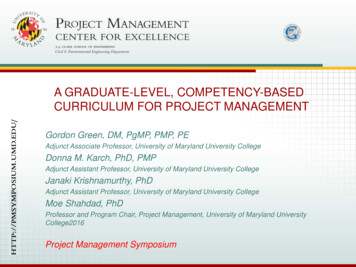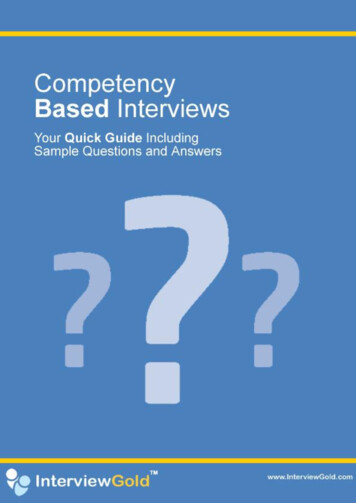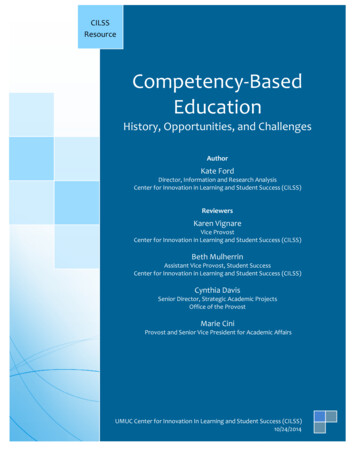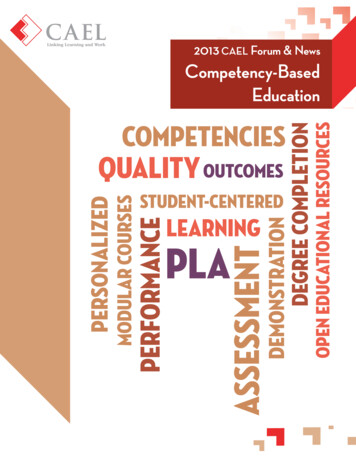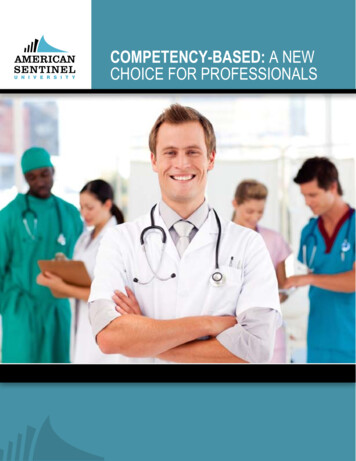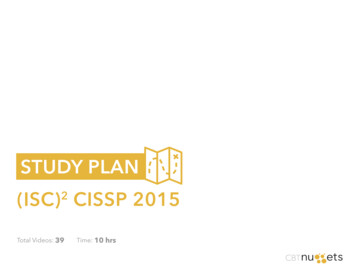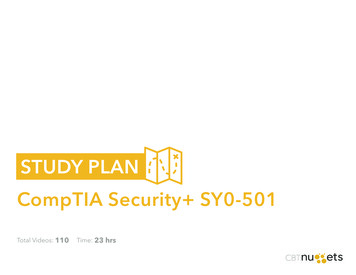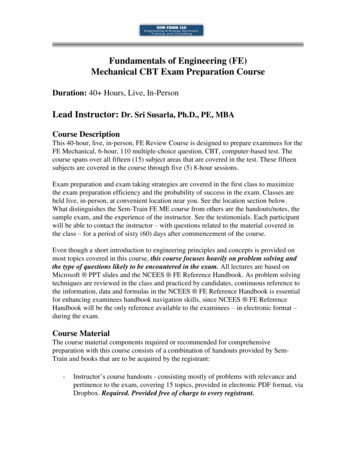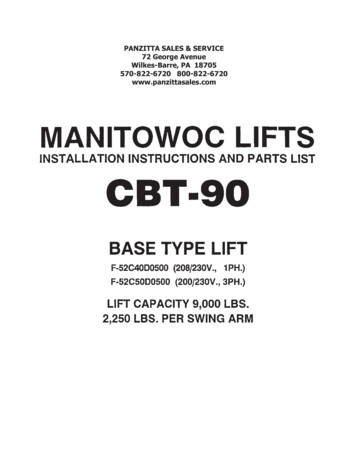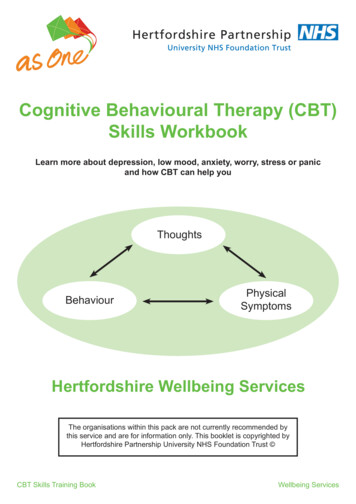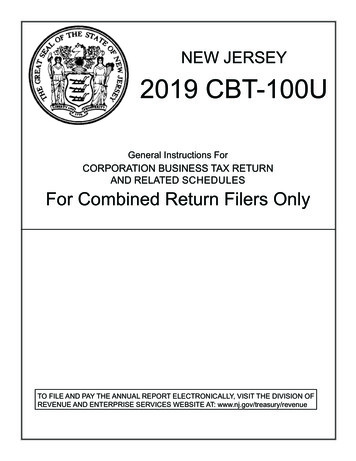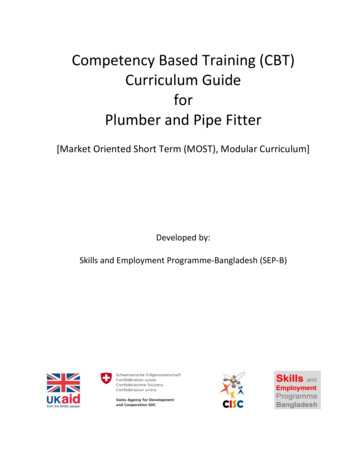
Transcription
Competency Based Training (CBT)Curriculum GuideforPlumber and Pipe Fitter[Market Oriented Short Term (MOST), Modular Curriculum]Developed by:Skills and Employment Programme-Bangladesh (SEP-B)
Table of Contents1. INTRODUCTION: . 12. AIMS: . 13. OBJECTIVES:. 14. DESCRIPTION: . 15. COURSE STRUCTURE: . 26. DURATION: . 27. TARGET GROUP: . 28. GROUP SIZE: . 29. TARGET LOCATION: . 210. MEDIUM OF INSTRUCTION: . 311. PATTERN OF ATTENDANCE: . 312. FOCUS OF THE PROGRAM: . 313. ENTRY CRITERIA: . 314. FOLLOW UP SUGGESTION: . 315. CERTIFICATE REQUIREMENT: . 316. TRAINEES EVALUATION DETAILS: . 317. TRAINERS’ QUALIFICATION: . 418. TRAINER – TRAINEES RATIO: . 419. SUGGESTION FOR INSTRUCTION:. 420. LIST OF MODULES AND SUB MODULES: . 421. MODULE SEQUENCE:. 422. DETAILS OF MODULES AND SUB MODULES: . 422.1. Module- 1: Practice Occupational Health and Safety (OHS) Procedure . 622.2. Module- 2: Apply Fundamental Skills of Plumbing & Pipe Fitting Works . 1122.3. Module- 3: Perform Basic Plumbing and Pipe Fitting Work. 1822.4. Module- 4: Installation of Fittings and Fixtures in Plumbing Works. . 2522.5. Module- 5: Repair & Maintenance of Plumbing Works . 4123. LIST OF TOOLS, EQUIPMENT AND MATERIALS:. 4924. PHYSICAL FACILITIES FOR 20 TRAINEES: . 5125. LIST OF TOOLS IN THE HAND TOOL BOX: . 5226. SUGGESTED REFERENCE BOOKS: . 5227. CURRICULUM TERMS AND DEFINITION: . 5328. CURRICULUM DEVELOPMENT TEAM: . 5429. REFERENCES: . 5430. LINKAGES OF SEP-B CURRICULUM WITH BTEB COMPETENCY STANDARDS: . 5531. SPECIAL NOTE FOR TRAINING PROVIDERS: . 55i
1. INTRODUCTION:The TVET system has a large role to play in economic growth and social development as workforceprovider to the labor market and as provider of skills to those who are looking for employment. In thecase of Bangladesh, the TVET sector needs major reforms to ensure that issues of quality and capacity,relevance, and access are properly addressed.This curriculum guide is designed and developed using competency based training (CBT) approachwith the aim of producing skilled human resources for respective trade and occupation. This is basedon the tasks to be performed for Plumber and Pipe Fitter occupation. The modules are included incourse structure section of this curriculum guide. The training methodology is learner friendly wheretheoretical inputs, demonstration, guided and individual practices will be sufficiently provided tomaster the skills at the industry standards. Sufficient and updated tools and equipment will also beused during the training to provide hands on skills to the trainees. The curriculum guide is developedin consultation with the trainer, mid-level industry supervisors, and skilled workers. Curriculum DesignAfrica has been involved to develop the curriculum.2. AIMS:The main aim of this training program is to produce medium level skilled workforce (semi-skilledworkers) required for the construction sector in the formal and informal sector and create betteropportunities for employment and increased revenue.3. OBJECTIVES:At the end of the training course, the trainees will be able to: Practice Occupational Health and Safety (OHS) Procedure Apply Fundamental Skills of Plumbing and Pipe Fitting Works Perform Basic Plumbing and Pipe Fitting Work Install Fittings and Fixtures in Plumbing Works Repair & Maintenance of Plumbing Works4. DESCRIPTION:This is a competency based training package for the unemployed and underemployed workforce ofBangladesh. The curriculum is based on the tasks to be performed in the Plumber and Pipe Fitteroccupation and subsequently these tasks have been grouped to form various modules. This willprovide flexibility for the trainees to learn one module at a time. The modules are included in the‘Course Structure’ section of this curriculum guide. The training methodology will be learner-centeredwhere theoretical input, demonstration, guided and individual practices will sufficiently be providedto the trainees to master their skills at business and industry standards. Sufficient tools, equipmentand aids will also be used during the training to provide hands on skills to the trainees.1
5. COURSE STRUCTURE:Job title: Plumber and Pipe FitterS.N.Time (hrs.)ModulesTasksNature1Practice Occupational Health and Safety (OHS)Procedure5T P2Apply Fundamental Skills of Plumbing and PipeFitting Works6T P3Perform Basic Plumbing and Pipe Fitting Work5T P4Installation of Fittings and Fixtures in PlumbingWorks11T P5Repair & Maintenance of Plumbing Works8T PAll 0.075.085.04.026.030.025.5154.5180Timings are subject to verification during pilot phase.It should further be noted that although Health and Safety is dealt with as a separate module, theprinciples should be integrated into each task. It should be seen as a way of life and not an activity tobe done during training only.6. DURATION:Total duration of the training is 180 hours excluding soft skills and On-the-Job Training(OJT)/Apprenticeship. The participants will be sent for wage employment after completion of thetraining. Only technical modules have been considered under this duration.7. TARGET GROUP:The target group of this training course will be dropped out youths from the formal schooling, jobseekers/underemployed young men or women, disadvantaged people. Male and female both areentitled to receive this training. The basic education for the trainees would be grade-V or equivalent.Above 18 years of age trainees will be enrolled in the training course.8. GROUP SIZE:A total of maximum 20 trainees will be placed in each group and provided adequate resources.9. TARGET LOCATION:The training will be implemented in partnership with private training providers situated in thedifferent areas of the country.2
10. MEDIUM OF INSTRUCTION:The medium of instruction for this course will be Bangla but the trainees will be oriented on technicalterminology in English.11. PATTERN OF ATTENDANCE:At least 90% attendee will be required during the theory and practical classes to appear in the internaland final assessment.12. FOCUS OF THE PROGRAM:Since this course is a competency based training, the focus is given on the performance of the traineesrather than the theoretical input. Where practicable, at least 80% of the total training time is allocatedfor practical training and 20% for theory.13. ENTRY CRITERIA:The following criteria will be considered for the individual to enter into this training program: Education: Class 5 or equivalent Age: 18 years and above Physical and mental health14. FOLLOW UP SUGGESTION:The training institutes who implement CBT program will build rapport with the employers to linkgraduates with the industries for employment.Placement: Within one month after completion of the training program, the graduates will be assistedin finding out appropriate and decent wage-based job relevant to the occupation concerned.To measure the success in job, the follow up will be taken as below:First follow-up- three months after placement of graduates in job and the next follow up six monthsafter placement of graduates in job.15. CERTIFICATE REQUIREMENT:Training service provider will certify the graduates as a Semi-Skilled Plumber and Pipe Fitter only aftersuccessful completion of the training program though systematic skills testing. Certification can alsobe linked to the Bangladesh Technical and Education Board (BTEB) at the relevant NTVQF levelthrough Recognition of Prior Learning (RPL).16. TRAINEES EVALUATION DETAILS:Monthly evaluation will be conducted to ensure the performance of the learners. Final evaluation willbe conducted to evaluate the participants at the end of the training course. Trainees must secure100% marks in practical and 80% marks in theoretical examination.3
17. TRAINERS’ QUALIFICATION:Preference will be given to the trainer’s having the following criteria: Minimum five years’ experience in the respective occupation in the construction industry Working experience as an Instructor/Trainer Trade course/Diploma Building Construction Technology18. TRAINER – TRAINEES RATIO: For theoretical class, trainer and trainee ratio should be 1:20.For practical class, trainer and trainee ratio should be 1:10.And for final practical assessment 1:119. SUGGESTION FOR INSTRUCTION:Where practicable: At least 80% time of the course will be allocated for practical purpose At least 20% time of the course will be allocated for theoretical purpose Follow the safety rules Create a friendly learning environment Arrange the materials and equipment at the right place Trainer/Instructor will be available in the training classes/labs in time Take attendance of participants Learner centered training Encourage the participants to speak Arrange question and answer (Q&A) sessions Make plans for classroom / workshop instructions Prepare lesson plans for theoretical and practical classes20. LIST OF MODULES AND SUB MODULES:Module: 1: Practice Occupational Health and Safety (OHS) ProcedureModule: 2: Apply Fundamental Skills of Plumbing and Pipe Fitting WorksModule: 3: Perform Basic Plumbing and Pipe Fitting WorkModule: 4: Installation of Fittings and Fixtures in Plumbing WorksModule: 5: Repair & Maintenance of Plumbing Works21. MODULE SEQUENCE:Start12345Finish22. DETAILS OF MODULES AND SUB MODULES:4
Module 1: Practice Occupational Health andSafety (OHS) Procedure5
22.1. Module- 1: Practice Occupational Health and Safety (OHS) ProcedureDescription: It consists of skills and knowledge related to occupationalhealth and safety applicable to the related performance.Module outcomes: After completion of this module, trainees will be ableto w safety sign and regulationsApply personal protective equipmentControl house-keeping hazardsApply First Aid on minor injuriesTask: Follow safety sign andregulationsTerminal PerformanceObjective (TPO):Given: Simulated situationWhat: Follow safety sign andregulationsSteps:1. Collect the safety sign, emergencyexit plan and list of rules andregulation2. Explain the application of safetysign and regulation3. Follow the emergency exit plan4. Comply with safety signs andregulations2.How well: All safety signs andregulationsmustbefollowed in the workplaceEnabling objectives: Explain about the uses of safety sign and regulation Explain how to use the regulation Explain what are the safety sign List the safety sign and regulation Use the all safety items and rules Explain the emergency exit wayTools/equipment/materials required: Safety sign, visual aids, danger zone area indicators andregulation chartsTask: Apply personal protectiveTerminal PerformanceTh.Pr.Tot.equipmentObjective (TPO):0.51.01.5G
The training methodology is learner friendly where theoretical inputs, demonstration, guided and individual practices will be sufficiently provided to master the skills at the industry standards. Sufficient and updated tools and equipment will also be used during the training to provide hands on skills to the trainees. The curriculum guide is developed
